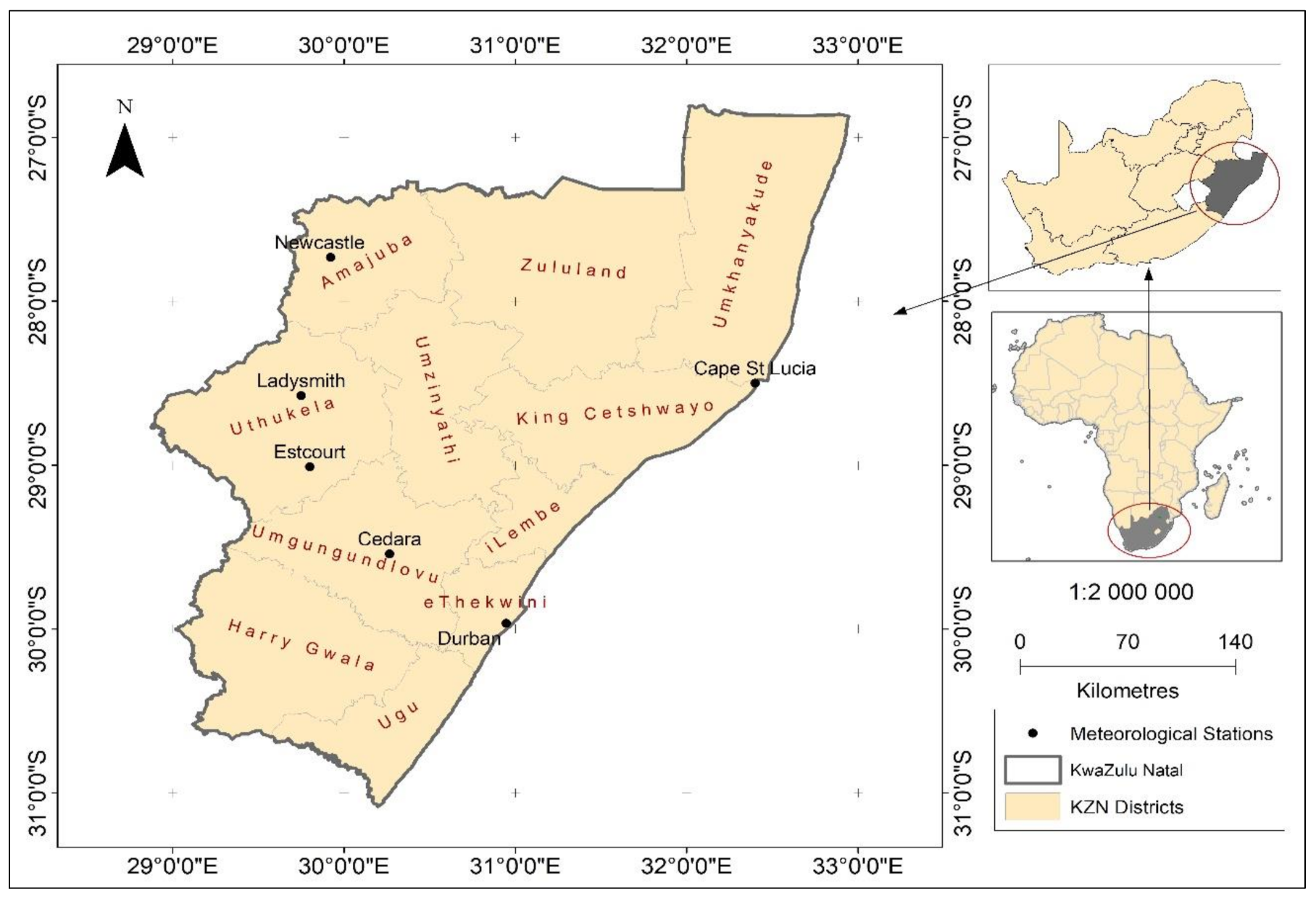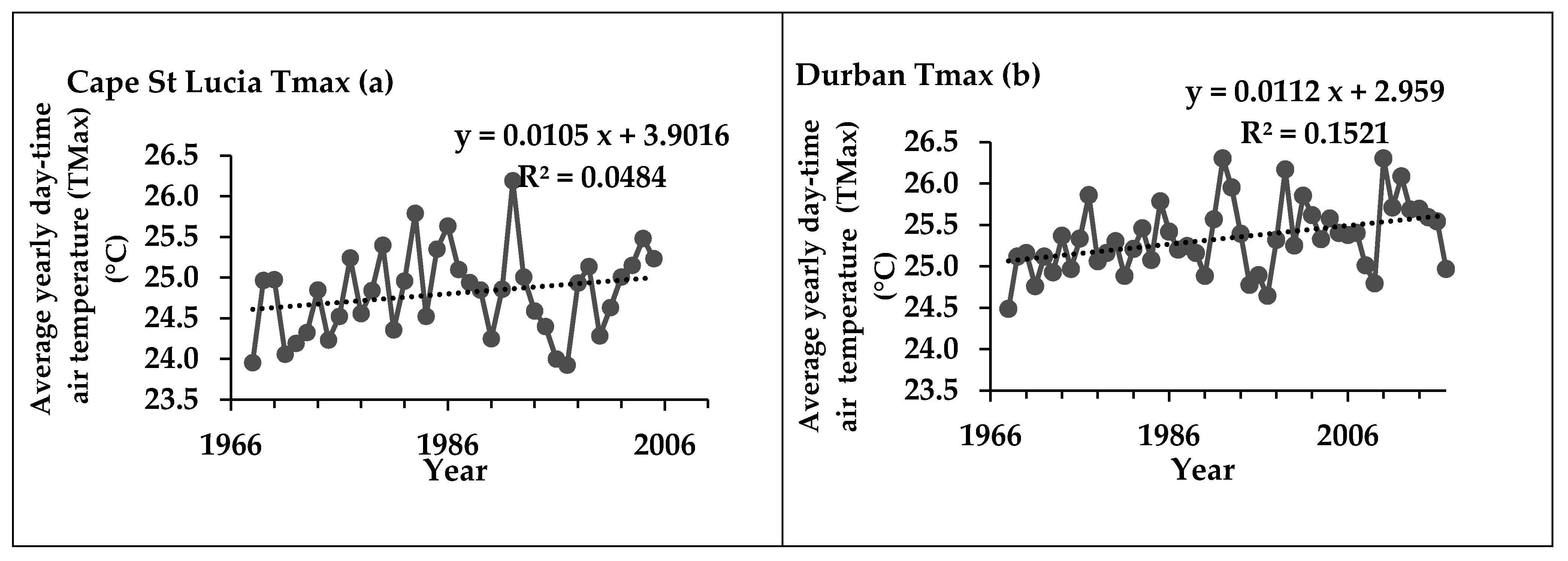An Assessment of the Impacts of Climate Variability and Change in KwaZulu-Natal Province, South Africa
Abstract
:1. Introduction
2. Materials and Methods
2.1. Climate of KwaZulu-Natal Province
2.2. Data Sources
2.2.1. Data Acquisition
2.2.2. Data Processing, Analysis, and Statistical Significance
2.2.3. Time Series Analysis Using MODIS NDVI Data
3. Results and Discussion
3.1. Annual Rainfall Trends
3.2. Monthly Rainfall Trend-Cycles
3.3. Annual Number of Rainy Days
3.4. Consecutive Dry Days (CDDs)
3.5. Consecutive Dry Days (CDDs) and Dry Spells
3.6. Consecutive Wet Days (CWDs)
3.7. Extreme Rainfall Days (R20)
3.8. Air Temperature Trends
3.9. Moisture Stress as a Proxy of NDVI
4. Conclusions
Supplementary Materials
Author Contributions
Funding
Institutional Review Board Statement
Data Availability Statement
Acknowledgments
Conflicts of Interest
References
- Bell, J.E.; Brown, C.L.; Conlon, K.; Herring, S.; Kunkel, K.E.; Lawrimore, J.; Luber, G.; Schreck, C.; Smith, A.; Uejio, C. Changes in extreme events and the potential impacts on human health. J. Air Waste Manag. Assoc. 2018, 68, 265–287. [Google Scholar] [CrossRef] [Green Version]
- Arora, N.K. Impact of climate change on agriculture production and its sustainable solutions. Environ. Sustain. 2019, 2. [Google Scholar] [CrossRef] [Green Version]
- Patz, J.A.; Grabow, M.L.; Limaye, V.S. When it rains, it pours: Future climate extremes and health. Ann. Glob. Health 2014, 80, 332–344. [Google Scholar] [CrossRef] [Green Version]
- Nhamo, L.; Mabhaudhi, T.; Modi, A. Preparedness or repeated short-term relief aid? Building drought resilience through early warning in southern Africa. Water SA 2019, 45, 75–85. [Google Scholar] [CrossRef] [Green Version]
- Mpandeli, S.; Nhamo, L.; Moeletsi, M.; Masupha, T.; Magidi, J.; Tshikolomo, K.; Liphadzi, S.; Naidoo, D.; Mabhaudhi, T. Assessing climate change and adaptive capacity at local scale using observed and remotely sensed data. Weather Clim. Extrem. 2019, 26, 100240. [Google Scholar] [CrossRef]
- Satterthwaite, D.; Archer, D.; Colenbrander, S.; Dodman, D.; Hardoy, J.; Mitlin, D.; Patel, S. Building resilience to climate change in informal settlements. One Earth 2020, 2, 143–156. [Google Scholar] [CrossRef] [Green Version]
- Sujakhu, N.M.; Ranjitkar, S.; He, J.; Schmidt-Vogt, D.; Su, Y.; Xu, J. Assessing the livelihood vulnerability of rural indigenous households to climate changes in Central Nepal, Himalaya. Sustainability 2019, 11, 2977. [Google Scholar] [CrossRef] [Green Version]
- Miralles, D.G.; Gentine, P.; Seneviratne, S.I.; Teuling, A.J. Land–atmospheric feedbacks during droughts and heatwaves: State of the science and current challenges. Ann. N. Y. Acad. Sci. 2019, 1436, 19. [Google Scholar] [CrossRef] [PubMed]
- McCabe, M.F.; Rodell, M.; Alsdorf, D.E.; Miralles, D.G.; Uijlenhoet, R.; Wagner, W.; Lucieer, A.; Houborg, R.; Verhoest, N.E.; Franz, T.E. The future of Earth observation in hydrology. Hydrol. Earth Syst. Sci. 2017, 21, 3879. [Google Scholar] [CrossRef] [Green Version]
- Wehrli, K.; Guillod, B.P.; Hauser, M.; Leclair, M.; Seneviratne, S.I. Identifying key driving processes of major recent heat waves. J. Geophys. Res. Atmos. 2019, 124, 11746–11765. [Google Scholar] [CrossRef]
- Richard, Y.; Fauchereau, N.; Poccard, I.; Rouault, M.; Trzaska, S. 20th century droughts in southern Africa: Spatial and temporal variability, teleconnections with oceanic and atmospheric conditions. Int. J. Climatol. 2001, 21, 873–885. [Google Scholar] [CrossRef]
- Moeletsi, M.E.; Walker, S.; Landman, W.A. ENSO and implications on rainfall characteristics with reference to maize production in the Free State Province of South Africa. Phys. Chem. Earth Parts A/B/C 2011, 36, 715–726. [Google Scholar] [CrossRef] [Green Version]
- Kane, R. Periodicities, ENSO effects and trends of some South African rainfall series: An update. S. Afr. J. Sci. 2009, 105, 199–207. [Google Scholar] [CrossRef] [Green Version]
- Rouault, M.; Roy, S.S.; Balling, R.C., Jr. The diurnal cycle of rainfall in South Africa in the austral summer. Int. J. Climatol. 2013, 33, 770–777. [Google Scholar] [CrossRef]
- Kruger, A.C.; Nxumalo, M. Historical rainfall trends in South Africa: 1921–2015. Water SA 2017, 43, 285–297. [Google Scholar] [CrossRef] [Green Version]
- Donat, M.; Alexander, L.; Yang, H.; Durre, I.; Vose, R.; Dunn, R.; Willett, K.; Aguilar, E.; Brunet, M.; Caesar, J. Updated analyses of temperature and precipitation extreme indices since the beginning of the twentieth century: The HadEX2 dataset. J. Geophys. Res. Atmos. 2013, 118, 2098–2118. [Google Scholar] [CrossRef]
- MacKellar, N.; New, M.; Jack, C. Observed and modelled trends in rainfall and temperature for South Africa: 1960–2010. S. Afr. J. Sci. 2014, 110, 1–13. [Google Scholar] [CrossRef] [Green Version]
- Connolly-Boutin, L.; Smit, B. Climate change, food security, and livelihoods in sub-Saharan Africa. Reg. Environ. Change 2016, 16, 385–399. [Google Scholar] [CrossRef] [Green Version]
- David, A.; Guilbert, N.; Hamaguchi, N.; Higashi, Y.; Hino, H.; Leibbrandt, M.; Shifa, M. Spatial Poverty and Inequality in South Africa: A Municipality Level Analysis; Southern Africa Labour and Development Research Unit, Uiveristy of Cape Town (UCT): Cape Town, South Africa, 2018; p. 39. [Google Scholar]
- Mosoetsa, S. Compromised communities and re-emerging civic engagement in Mpumalanga Township, Durban, KwaZulu-Natal. J. South. Afr. Stud. 2005, 31, 857–873. [Google Scholar] [CrossRef]
- Bhaga, T.D.; Dube, T.; Shekede, M.D.; Shoko, C. Impacts of Climate Variability and Drought on Surface Water Resources in Sub-Saharan Africa Using Remote Sensing: A Review. Remote Sens. 2020, 12, 4184. [Google Scholar] [CrossRef]
- Davis, C.L.; Vincent, K. Climate Risk and Vulnerability: A Handbook for Southern Africa, 2nd ed.; Council for Scientific and Industrial Research (CSIR): Pretoria, South Africa, 2017; p. 202. [Google Scholar]
- Sahani, J.; Kumar, P.; Debele, S.; Spyrou, C.; Loupis, M.; Aragão, L.; Porcù, F.; Shah, M.A.R.; Di Sabatino, S. Hydro-meteorological risk assessment methods and management by nature-based solutions. Sci. Total Environ. 2019, 696, 133936. [Google Scholar] [CrossRef]
- Kruger, A. Climate of South Africa: Climate Regions; South African Weather Service: Pretoria, South Africa, 2004; p. 19.
- Ndlovu, M.S.; Demlie, M. Assessment of meteorological drought and wet conditions using two drought indices across KwaZulu-Natal Province, South Africa. Atmosphere 2020, 11, 623. [Google Scholar] [CrossRef]
- Alexander, L.V. Global observed long-term changes in temperature and precipitation extremes: A review of progress and limitations in IPCC assessments and beyond. Weather Clim. Extrem. 2016, 11, 4–16. [Google Scholar] [CrossRef] [Green Version]
- Zoungrana, B.J.; Conrad, C.; Thiel, M.; Amekudzi, L.K.; Da, E.D. MODIS NDVI trends and fractional land cover change for improved assessments of vegetation degradation in Burkina Faso, West Africa. J. Arid Environ. 2018, 153, 66–75. [Google Scholar] [CrossRef]
- De Waal, J.H.; Chapman, A.; Kemp, J. Extreme 1-day rainfall distributions: Analysing change in the Western Cape. S. Afr. J. Sci. 2017, 113, 1–8. [Google Scholar] [CrossRef] [Green Version]
- Nel, W. Observations on daily rainfall events in the KwaZulu-Natal Drakensberg. Water SA 2008, 34, 271–274. [Google Scholar] [CrossRef] [Green Version]
- Wang, J.; Xu, C.; Hu, M.; Li, Q.; Yan, Z.; Jones, P. Global land surface air temperature dynamics since 1880. Int. J. Climatol. 2018, 38, e466–e474. [Google Scholar] [CrossRef]
- Van Loon, A.F. Hydrological drought explained. Wiley Interdiscip. Rev. Water 2015, 2, 359–392. [Google Scholar] [CrossRef]














| Climatic Region | Locality | Properties |
|---|---|---|
| Region 6 Savanna-type climatic region eastern coastal bushveld | East coast of KZN stretching towards the Drakensberg region | Austral summer rainfall region Average annual rainfall of up to 1400 mm Wet and humid region |
| Region 7 Savanna-type climatic region KwaZulu-Natal central bushveld | Northern part of KZN | Austral summer rainfall region Average annual rainfall of 900 mm Cold in winter 90–150 frost days in a year Very hot in summer |
| Region 12 Grassland type climatic region, eastern grassland | Southern part of KZN | Austral summer rainfall zone Annual rainfall range 650–1000 mm Highly intense thunderstorms and snow on higher altitudes |
| Station | Latitude | Longitude | Elevation (m) | Region (Kruger Classification) [15] |
|---|---|---|---|---|
| Cape St Lucia | −28.5 | 32.4 | 107 | 6 |
| Cedara | 29.541 | 30.265 | 1071 | 12 |
| Durban South | −29.965 | 30.946 | 14 | 6 |
| Estcourt | −29.01 | 29.8 | 1159 | 12 |
| Ladysmith | −28.575 | 29.75 | 1069 | 7 |
| Newcastle | −27.732 | 29.921 | 1235 | 7 |
| Index | Index in Full | Description | Unit |
|---|---|---|---|
| CDDs | Consecutive dry days | Max. number of consecutive days when rainfall is <1 mm | Day |
| CWDs | Consecutive wet days | Max. number of consecutive days when rainfall is ≥1 mm | Day |
| R20 | Very heavy rainfall days | Annual count when rainfall is ≥20 mm | Day |
| TXx | MaxTmax | Monthly max. value of daily max. air temperature | °C |
| TNn | MinTmin | Monthly min. value of daily min. air temperature | °C |
| Region | Station | Highest Annual Rainfall and Year | Lowest Annual Rainfall and Year |
|---|---|---|---|
| 6 | Cape St Lucia | 2283.5 (1984) | 719.6 (1992) |
| Durban South | 1422.0 (1996) | 291.0 (2014) | |
| 7 | Ladysmith | 1044.8 (1996) | 355.8 (2015) |
| Newcastle | 1351.9 (1996) | 465.7 (2002) | |
| 12 | Cedara | 1461.0 (1987) | 535.2 (2015) |
| Estcourt | 1126.9 (1996) | 267.2 (2012) |
| Key Results | Repercussions | Recommendation | SDG |
|---|---|---|---|
| The decreasing number of rainfall days | • Shorter planting seasons • Lack of water • Gradual aridification | • Invest in water storage infrastructure and water conservation • Adopt different crop varieties • Adaptive agriculture | 6 |
| High intra-inter seasonal rainfall variability | • Seasonally subjective water availability • Dry spells especially during the climatologically dry months • Short/shifted planting seasons • Unpredictable rainfall regimes | • Adaptive agriculture • Soil-moisture conservation • Change planting dates • Invest in water storage facilities | 2,6 |
| Increased R20 and CWDs | • High risk of flooding, flash flooding and torrential rainfall • High risk of wet spells • High risk of soil erosion and increased runoff | • Sector-based flood planning • Create runoff paths • Plants crops that withstand floods | 2,6,15 |
| Highly variable regional rainfall and air temperature regimes | • Area-specific agro-ecological, agro-meteorological, and general problems | • Tailor-made adaptation strategies • Crop diversification | 6 |
| An increasing number of CDDs | • High risk of dry spells and drought • Water shortages • Crop-water stress • Extreme air temperatures | • Adopting local crop varieties • Use different and tolerant crop varieties and adopt suitable agronomic management strategies • Crop diversification • Invest in irrigation infrastructure • design soil–water conservation strategies | 1,2,3,6 |
| Increasing day-time and night-time air temperature | • Increased evapotranspiration and crop-water stress • High risk of heatwaves • Increased risk of wildfires • Affects crop physiology and growth | • Adopt appropriate agronomic measures • Water storage • Irrigation | 1,2,3 |
Publisher’s Note: MDPI stays neutral with regard to jurisdictional claims in published maps and institutional affiliations. |
© 2021 by the authors. Licensee MDPI, Basel, Switzerland. This article is an open access article distributed under the terms and conditions of the Creative Commons Attribution (CC BY) license (http://creativecommons.org/licenses/by/4.0/).
Share and Cite
Ndlovu, M.; Clulow, A.D.; Savage, M.J.; Nhamo, L.; Magidi, J.; Mabhaudhi, T. An Assessment of the Impacts of Climate Variability and Change in KwaZulu-Natal Province, South Africa. Atmosphere 2021, 12, 427. https://doi.org/10.3390/atmos12040427
Ndlovu M, Clulow AD, Savage MJ, Nhamo L, Magidi J, Mabhaudhi T. An Assessment of the Impacts of Climate Variability and Change in KwaZulu-Natal Province, South Africa. Atmosphere. 2021; 12(4):427. https://doi.org/10.3390/atmos12040427
Chicago/Turabian StyleNdlovu, Mendy, Alistair D. Clulow, Michael J. Savage, Luxon Nhamo, James Magidi, and Tafadzwanashe Mabhaudhi. 2021. "An Assessment of the Impacts of Climate Variability and Change in KwaZulu-Natal Province, South Africa" Atmosphere 12, no. 4: 427. https://doi.org/10.3390/atmos12040427
APA StyleNdlovu, M., Clulow, A. D., Savage, M. J., Nhamo, L., Magidi, J., & Mabhaudhi, T. (2021). An Assessment of the Impacts of Climate Variability and Change in KwaZulu-Natal Province, South Africa. Atmosphere, 12(4), 427. https://doi.org/10.3390/atmos12040427








